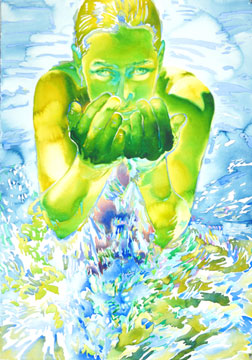FEBRUARY 19 – MARCH 28, 2007
- Reception: Thursday, February 22, 2007, 6-8 p.m.
- Curator’s talk at 7 p.m.
- Music by Jordan Kaye in the Gallery Lounge
 Renowned watercolor artists from across the country displayed their unique creations during the "State of the Art 2007," the 10th Biennial Watercolor Invitational.
Renowned watercolor artists from across the country displayed their unique creations during the "State of the Art 2007," the 10th Biennial Watercolor Invitational.
This invitational provided an in-depth look at influential contemporary watercolorists. Guest curator Robert Barnum, associate professor in art at Ferris State University in Michigan, has selected 10 artists to do this. He says his chosen artists “represent a level of voice and a level of image that serve as examples of this impossible artistic game played at the highest level.”
Participating artists include Carol Carter (St. Louis, Missouri); Wayne Conyers (McPherson, Kansas); Terry Genesen-Becker (Minneapolis, Minnesota); Harold Gregor (Bloomington, Illinois); Don Lake (Champaign, Illinois); Brian Paulsen (Grand Folks, North Dakota); Charles Reid (Green Farms, Connecticut); Robert Remsen Vickrey (Orleans, Massachusetts); Warren Taylor (Midland, Texas); and Andrew Wyeth (Chadds Ford, Pennsylvania). “As far as I’m concerned, the artists chosen were obvious choices; they bring as creative individuals a level of image and a personal conversation to their work that inspires award and public exhibit,” Barnum said.
Carter, one of the artists selected for the show, will be spoke about her work on Thursday, March 29 at the Parkland College campus. “In much of my work, water, either literal or suggested, provides the setting for anonymous figures,” she said. “Having grown up in Florida, my strongest visual impression of an environment for human activity is water. For me, painting should possess and intimacy, a mysteriousness, a sensuality. At its best, my work has an edge; something in it that takes a moment; a second look; and effort to comprehend.”
The works on display from Lake, professor emeritus at Parkland, are from his series “Industry.” They include vibrant colors and are strongly representational. “I have explored factories and industrial sites in America; these visits stimulate all of my senses and feed my never-ending fascination for painting complex patterns, textural surfaces, and a dramatic play of light and color,” Lake said. “Once ubiquitous in the American landscape and central to our economy, many “smokestack” factories are now relics of another time.”
Taylor, who says he is not “a formula painter in traditional watercolor,” says his subject matter “seems to drift around somewhat. Most of my works over the years have dealt with existing imagery of various sorts, from differing perspectives or contexts. Watercolor is a beautiful medium, but like a pretty or handsome face, there has to be some dimension behind it. I resist seeing this medium in an isolated camp, but instead think of it as serving mainstream contemporary artists, and very well at that.”
The exhibition included a watercolor by Andrew Wyeth, courtesy of the University of Illinois’ Krannert Art Museum collection. Born in 1917 and successful early in his career, Wyeth is practically a household name among artists and highly acclaimed for his works. “We are excited to have a work of Andrew Wyeth in the exhibition,” said Lisa Costello, art gallery director. “He is an influential painter who ‘completes’ this exhibition. Robert Barnum had wanted an example of Wyeth’s work, so I am pleased that Krannert was able to loan us this piece.”